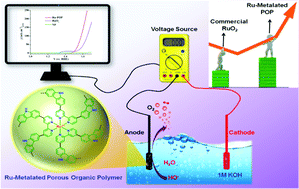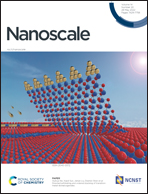Electrocatalytic water oxidation performance in an extended porous organic framework with a covalent alliance of distinct Ru sites†
Abstract
The rational synthesis of durable, earth-abundant efficient electrocatalysts for the oxygen evolution reaction (OER) from water is one of the most important routes for storing renewable energy and minimizing fossil fuel combustion. The prime hurdles for effectively utilizing commercial RuO2 as (OER) electrocatalysts are its very low stability, catalyst deactivation, and high cost. In this work, we explored a Ru-integrated porous organic polymer (Ru@Bpy-POP) by a facile one-pot Friedel–Crafts alkylation strategy between redox-active (Ru(demob)3Cl2) and a carbazole unit, which is composed of unique features including an extended framework unit, isolated active sites, and tunable electrode kinetics. Ru@Bpy-POP can serve as a bridge between a Metal–Organic Framework (MOF) and POP-based catalytic systems with a balanced combination of covalent bonds (structural stability) and open metal sites (single site catalysis). Ru@Bpy-POP, deposited on a three-dimensional nickel foam electrode support, exhibits a promising electrocatalytic OER activity with an ultra-low ruthenium loading compared to a benchmark RuO2 catalyst, providing an overpotential of about 270 mV to reach 10 mA cm−2 in an alkaline medium. Moreover, a high current density of 248 mA cm−2 was achieved for the Ru@Bpy-POP catalyst at only 1.6 V (vs. RHE), which is much higher than 91 mA cm−2 for commercial RuO2. The robust, albeit highly conjugated, POP framework not only triggered facile electro-kinetics but also suppressed aggregation and metallic corrosion during electrolysis. In particular, the benefits of covalent integration of distinct Ru sites into the framework can modulate intermediate adsorption and charge density, which contributes to its exceptional OER activity. All of the critical steps involved in OER are complemented by Density Functional Theory (DFT) calculations, which suggest that electrocatalytic water oxidation proceeds from a closed-shell configuration to open-shell electronic configurations with high-spin states. These open-shell configurations are more stable than their closed-shell counterparts by 1 eV, improving the overall catalytic activity.

- This article is part of the themed collection: Nanoscale Horizons, Nanoscale, and ChemComm: Nanocatalysis


 Please wait while we load your content...
Please wait while we load your content...